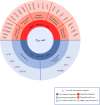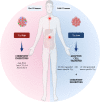Tissue-resident memory T cells in gastrointestinal cancer immunology and immunotherapy: ready for prime time?
- PMID: 35470231
- PMCID: PMC9039405
- DOI: 10.1136/jitc-2021-003472
Tissue-resident memory T cells in gastrointestinal cancer immunology and immunotherapy: ready for prime time?
Abstract
Tissue-resident memory T (TRM) cells have emerged as immune sentinels that patrol the tissue microenvironment and orchestrate localized antitumor immunity in various solid cancers. Recent studies have revealed that TRM cells are key players in cancer immunosurveillance, and their involvement has been linked to favorable responses to immunotherapy as well as general better clinical outcome in cancer patients. In this review, we provide an overview of the major advances and recent findings regarding TRM cells phenotype, transcriptional and epigenetic regulation in cancer with a special focus on gastrointestinal tumors. Finally, we highlight the exciting clinical implication of TRM cells in these types of tumors.
Keywords: gastrointestinal neoplasms; immunity; immunologic memory; immunotherapy.
© Author(s) (or their employer(s)) 2022. Re-use permitted under CC BY-NC. No commercial re-use. See rights and permissions. Published by BMJ.
Conflict of interest statement
Competing interests: None declared.
Figures




References
Publication types
MeSH terms
LinkOut - more resources
Full Text Sources
